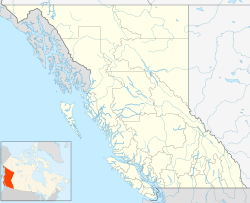Dog Creek | |
|---|---|
Location of Dog Creek in British Columbia | |
| Coordinates: 51°34′53″N122°14′08″W / 51.58139°N 122.23556°W | |
| Country | |
| Province | |
| Area codes | 250, 778 |
Dog Creek is an unincorporated ranching settlement, located on the Fraser River, in the Cariboo region of British Columbia, Canada. Located on the northeast side of the Fraser's confluence with Dog Creek, [1] it is opposite Gang Ranch on the west side of the river, which is connected by an old suspension bridge serving local ranch roads. Dog Creek's first post office opened in 1873. The Dog Creek reserves of the Canoe Creek/Dog Creek Indian Band are located east of the settlement. The ranches at Dog Creek, along with the Gang Ranch, mostly hire First Nations cowboys, most of them coming from the Canoe Creek/Dog Creek Band.
